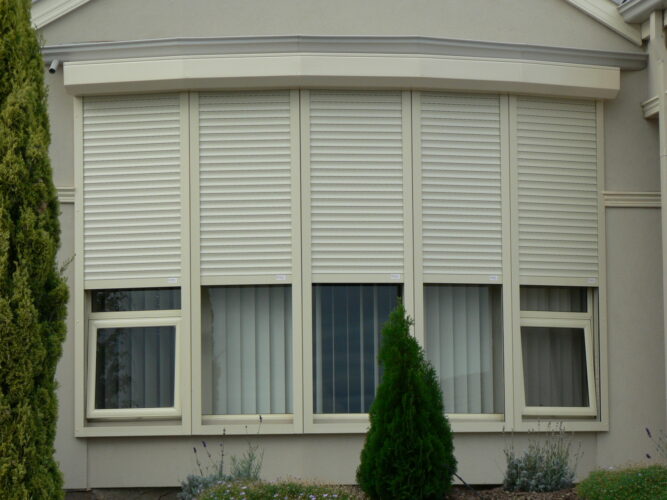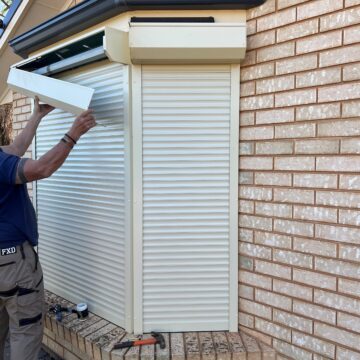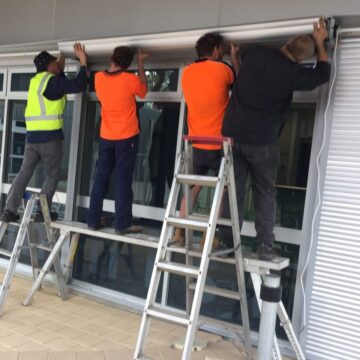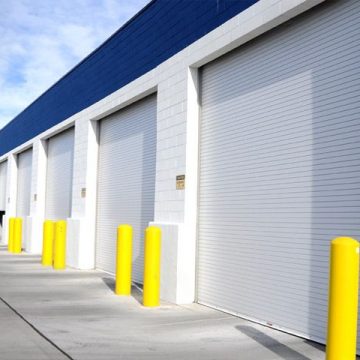Aluminium roller shutters are protective, insulated window and door coverings made from interlocking slats that roll up into a compact headbox. Fitted outside your opening and operated manually or by electric, battery or solar motor, they give you security, privacy and control over heat, glare and noise. In summer they help keep homes cooler; in winter they cut draughts. They also protect glass from storms and reduce light for bedrooms, nurseries and media rooms.
This guide explains what roller shutters do, when they suit Australian homes and businesses, and how they’re built. You’ll see the differences between foam‑filled and extruded slats, compare manual and powered options, understand energy, security and BAL compliance, and explore colours and installation styles. We’ll also cover smart controls, pricing, where to buy, DIY versus professional install, install timeline, repairs and choosing a reputable supplier.
What aluminium roller shutters do and when they make sense
Aluminium roller shutters give you on-demand control of light, heat, noise and security. Close them to block sun and glare, cut heat transfer and draughts, dampen traffic noise, and create near blackout. They add a strong external barrier that deters break-ins and shields glass from storms. They make sense for street‑facing rooms, bedrooms and nurseries, shift workers needing daytime darkness, coastal and high‑wind areas common in Australia, and shopfronts needing after‑hours protection. They suit both retrofits and new builds, including wide doors and odd sizes. If you want low‑maintenance, locally made protection with year‑round comfort and privacy, shutters are a smart, long‑term upgrade.
Key components and how a roller shutter works
At heart, an aluminium roller shutter is a straightforward system. Interlocking aluminium slats (the “curtain”) slide inside side guides and coil around a drive tube inside a compact, powder‑coated headbox. A weighted bottom rail helps seal the sill. You raise and lower the curtain by manual strap/winder or a tubular motor (mains, battery or solar), with the side guides keeping everything aligned and secure.
- Curtain/slats: Interlocking aluminium profiles that create the protective barrier.
- Side guides/tracks: Aluminium channels that retain and stabilise the curtain.
- Bottom rail: Weighted finishing bar that improves seal; can include key lock.
- Drive tube + spring/motor: Provides lifting force and smooth control.
- Headbox/hood: Encloses the rolled curtain and protects the mechanism.
In use, the curtain unrolls to close, the slats flattening into a rigid sheet that resists prying and weather. Opening reverses the cycle, the slats neatly coiling into the headbox to restore light and views without taking interior space.
Aluminium slat options: foam-filled vs extruded
The slats are the engine room of aluminium roller shutters. In Australia, you’ll typically choose between lighter roll‑formed, foam‑filled slats and heavier extruded aluminium profiles. Foam‑filled slats pair a thin aluminium skin with an insulating core, offering quieter operation and thermal comfort that suits most homes. Extruded slats are one-piece, thicker aluminium sections, delivering higher strength for security, wider spans and tougher environments—commonly used on shopfronts and commercial sites.
- Foam‑filled (roll‑formed): Lightweight, insulating and quiet; cost‑effective; compact headboxes that suit residential windows and bedrooms.
- Extruded aluminium: Heavy‑duty strength for security and wide openings; widely specified for commercial/industrial shutters; available in fire‑rated, CSIRO‑tested profiles in Australia.
- Finishes and colours: Both types are powder‑coated to match façades; some ranges offer thicker‑gauge aluminium for extra durability.
Operation types: manual, electric, battery and solar
How your aluminium roller shutters operate will shape everyday convenience, installation complexity and long‑term upkeep. From simple manual winders to fully powered systems, the right choice depends on window size, access, cabling options and whether you’re retrofitting or building new. Here’s how the main operation types compare for Australian homes and businesses.
- Manual (strap or winder): Lowest cost, no wiring, dependable. Best for small to medium windows within easy reach.
- Electric (mains motor): One‑touch control via wall switch or remote; ideal for groups and schedules. Requires a licensed electrician.
- Battery motor (rechargeable): Wire‑free retrofit with minimal disruption; neat finish. Periodic charging or battery swap required.
- Solar motor: Discreet panel charges an internal battery; great where cabling is difficult. Works best on sun‑exposed elevations with correct panel positioning.
Benefits you can expect in Australian homes and businesses
Fitted to the outside of windows and doors, aluminium roller shutters deliver everyday comfort, protection and control that suits Australian conditions—think harsh sun, summer heat, coastal winds and busy streets. Whether you’re securing a shopfront after hours or improving sleep in a street‑facing bedroom, the gains are practical, immediate and long‑lasting.
- Better thermal comfort: Cut heat gain in summer and reduce winter draughts to steady indoor temperatures.
- Light and glare control: From soft dimming to near blackout for bedrooms, nurseries and media rooms.
- Security and deterrence: A robust external barrier that helps discourage break‑ins and shields glass.
- Noise reduction: Dampen traffic, neighbour and machinery noise for quieter living and workspaces.
- Weather protection: Protect windows from wind‑driven rain, debris and harsh UV that fades interiors.
- On‑demand privacy: Block lines of sight in overlooked or street‑level rooms without sacrificing style.
- Low maintenance: Powder‑coated aluminium resists corrosion and cleans up with simple washing.
Energy efficiency and insulation performance
Because they sit outside the glass, aluminium roller shutters stop heat before it enters the building envelope. In summer, the shutter shades the pane and the still air cavity between slats and glass acts as a buffer against radiant and convective heat. In winter, a closed curtain cuts draughts at the frame and reduces conductive heat loss through the glazing. Foam‑filled slats add a thermal break, while well‑fitted side guides and a weighted bottom rail improve the seal for steadier indoor temperatures and lower energy use.
- Slat type: Foam‑filled improves insulation; extruded prioritises strength over thermal performance.
- Fit and sealing: Tight tracks and sill seals reduce air leakage.
- Orientation and colour: West/north elevations gain most; lighter colours reflect more sun.
- Control strategy: Close before peak heat; automate opening/closing to match weather for best results.
Security, privacy and noise reduction
Close the curtain and the street disappears. Aluminium roller shutters deliver instant privacy and a visible security upgrade. Interlocking slats run captive inside side guides, forming a rigid barrier that shields glass and deters opportunistic entry. A weighted bottom rail improves sealing, and many systems offer a key‑locking bottom bar. In higher‑risk areas or wide openings, extruded aluminium slats increase strength.
They also quieten rooms. By stopping wind pressure on the pane and creating a mass‑plus‑air gap at the window, shutters help dampen traffic, neighbour and machinery noise so bedrooms and offices feel calmer. Maximise results with snug tracks, good sill seals and timely closing before peak noise.
Bushfire, wind and compliance in Australia (BAL and Australian Standards)
Across Australia, aluminium roller shutters are often chosen to address bushfire risk and high winds. In bushfire‑prone areas, your shutter choice and installation should align with your site’s BAL assessment and relevant Australian Standards. For higher exposure, stronger extruded aluminium slats and robust tracks are preferred. Some Australian suppliers offer CSIRO‑tested, fire‑rated extruded profiles, providing additional assurance for compliance‑minded projects.
- BAL sites: Confirm your BAL with the certifier, then request product evidence (e.g., CSIRO‑tested fire‑rated extruded slats) and a tight, well‑sealed install to limit gaps.
- High winds/coastal: Choose extruded slats, sturdy side guides and professional fixings; seek advice on maximum spans and bracket spacing.
- Compliance: Ask for written confirmation that products and installation meet applicable Australian Standards and local council requirements; use a licensed electrician for powered units.
Design choices: colours, boxes and installation styles
Thoughtful design turns aluminium roller shutters into a seamless part of your façade. You’ll choose a colour and finish, a headbox style, track detailing and how the shutter is mounted. These decisions affect visual bulk, weather performance and how “built-in” the result looks, especially on street‑facing windows and doors.
- Colours and finishes: Durable powder‑coating to match frames, fascia or cladding, or create contrast for a modern accent.
- Headbox (hood) profile: Square or curved styles; the box size grows with opening height and slat type (extruded typically needs a larger box).
- Tracks and bottom rail: Colour‑match for a discreet look; consider low‑profile guides and optional key‑locking bottom bars.
- Installation style: Face‑fit (on the façade) maximises coverage and weathering; reveal‑fit (inside the opening) looks cleaner but needs precise clearances. New builds can recess or partly conceal boxes; retrofits favour neat, surface‑mounted solutions.
Residential vs commercial applications
At home, aluminium roller shutters deliver comfort: heat and glare control, blackout for bedrooms, privacy on street‑facing windows and quieter interiors. Foam‑filled slats with compact headboxes suit most windows, with manual or retrofit battery/solar drives for tidy installs.
Commercial sites prioritise strength and access control. Extruded aluminium slats, robust tracks and locking options suit shopfronts and warehouses, typically with mains‑powered motors for daily cycles and central control across wider openings.
Smart controls and home automation
Smart controls make aluminium roller shutters easier to live with every day. Most mains‑powered shutters run from a wall switch or RF remote and can be linked to a compatible smart hub for app control and automation. Battery and solar motors typically use the same remotes, with optional gateways for phone control without wiring. For any mains‑powered smart controller or wiring changes in Australia, use a licensed electrician.
- App and voice control: Open, close and stop at preferred positions.
- Schedules and scenes: Automate by time of day and create “leave home” or “goodnight” routines.
- Grouping and zones: Move multiple shutters together by room, floor or façade.
- Security and comfort: One‑tap close when leaving; pre‑close west windows before afternoon heat.
Pricing in Australia: typical costs and what affects your quote
For budgeting, aluminium roller shutters in Australia commonly start from entry-level manual units around $300–$350 for smaller openings, with a broader typical range of about $300–$1,000 per shutter depending on size, quality and design. Powered options, premium slats and complex installs sit toward the upper end. Quotes are usually provided per opening and include measure and installation, with electrical work itemised for mains-powered systems.
- Size and span: Larger, wider shutters cost more.
- Slat type: Extruded aluminium (stronger) costs more than foam‑filled.
- Operation: Manual is cheapest; electric, battery and solar add hardware and setup.
- Electrical works: Licensed electrician costs for mains motors and smart controllers.
- Install complexity: Two‑storey access, tight reveals or difficult façades.
- Controls and extras: Remotes, grouped control, smart hubs and key‑locking bottom bars.
- Compliance needs: Fire‑rated/extruded profiles and wind load requirements can add cost.
Australian brands and where to buy (big-box vs specialist)
Australia has a strong local ecosystem for aluminium roller shutters. Big‑box retailers like Bunnings stock off‑the‑shelf options and DIY kits at warehouse prices, handy for straightforward windows and quick Click & Collect. Specialists—factory‑direct and dealer networks—offer custom sizing, colour‑matched powder‑coating, professional installation and aftercare. Notable names include Ozroll, CW Products, Steel‑Line, Mirage Doors, Austral Monsoon and Apollo. In Adelaide, Classic Roller Shutters provides locally manufactured, measured‑to‑fit solutions with installation and repairs.
DIY kits vs professional supply and install
DIY kits for aluminium roller shutters can be a budget‑friendly option for straightforward, ground‑floor windows—especially manual units or battery/solar retrofits where you want minimal wiring. Professional supply and install shines when you’re dealing with multiple openings, powered systems, tight reveals, upper storeys or compliance requirements.
- DIY kits:
- Lower upfront cost and fast availability from big‑box retailers.
- Requires precise measuring, square openings and confident fixing.
- No DIY mains wiring—licensed electrician needed for powered units.
- Risk of re‑ordering if sizes are wrong; parts‑only warranties are common.
- Professional install:
- Site measure, custom manufacture and neat cable management.
- Advice on slat type, spans, wind/BAL considerations.
- Commissioning, handover and consolidated product/installation warranties.
- Safer access for heights and cleaner, façade‑matched finishes.
The installation process from quote to handover
With a reputable supplier, installation of aluminium roller shutters is a straightforward, factory‑made process. It begins with a free measure (or a quote from plans) to lock in sizes, slat type, colours and how you’ll operate the shutters. After you approve the fixed quote, your shutters are custom‑built. If you’ve chosen mains‑powered motors, a licensed electrician completes any pre‑wire or power points before installation day.
- Site measure or plan check: confirm sizes, spans, tracks and clearances.
- Final selections: colours, slat profile, manual or powered controls, extras.
- Order and manufacture: made‑to‑measure at the factory.
- Pre‑wire (if required): electrician prepares cabling and switches.
- Installation: fit guides and headbox, plumb/level, secure to substrate, seal.
- Commissioning: set motor limits, pair remotes, group zones, test operation.
- Handover: demonstration, care guide, warranty and electrical compliance paperwork.
Maintenance and cleaning checklist
Aluminium roller shutters are low‑maintenance, but a quick seasonal check keeps them smooth, quiet and looking sharp. Work from the ground where possible, isolate power before hands‑on checks, use gentle cleaners, and leave headbox internals to a licensed professional only.
- Wash: Mild soapy water, soft brush, hose; no pressure washers.
- Tracks & seals: Clear grit; light silicone in guides; check bottom rail and screws.
- Controls: Test travel; swap remote batteries; confirm chargers/solar connected.
Repairs and common issues (tapes, slats, motors, remotes)
Aluminium roller shutters are durable, but moving parts wear. Most issues are fixable without replacing the whole unit. Start with basic checks, isolate power before testing motors, and use a licensed electrician for any mains‑powered work. For upper‑storey windows or heavy curtains, call a specialist.
- Tapes/straps/winders: Frayed or slipping — replace and re‑tension.
- Slats/end‑clips: Dents or dropouts — swap damaged pieces.
- Jams in tracks: Grit or bowed guides — clean and realign.
- Motors dead: No power or seized — diagnose, replace if failed.
- Limits off: Won’t fully open/close — reset upper/lower limits.
- Remotes/radio: Flat battery or unpaired — replace battery, re‑pair.
Upgrades and retrofits for existing shutters
Most existing aluminium roller shutters can be modernised without replacing the whole unit. Popular upgrades include swapping worn manual tapes for tube motors (mains, battery or solar), replacing tired motors, adding smart controls, new remotes and grouped control, fitting key‑locking bottom rails, refreshing tracks, seals and end clips, and re‑slatting damaged curtains. A site check confirms headbox sizes, power access and compatibility before quoting.
Lead times, warranties and aftercare
Aluminium roller shutters are made to measure, so timelines depend on site measure, factory queue, slat type, colour availability, number of openings and any electrical pre‑wiring. Big‑box, off‑the‑shelf units are fast; custom, powder‑coated shutters from specialists take longer. Warranties differ by brand and component—get them in writing. Aftercare matters: routine cleaning and local repair support minimise downtime.
- Quoted lead time: Install window and any pre‑wire date.
- Warranty split: Slats/powder‑coat, motor, controls, workmanship.
- What starts the clock: Invoice or installation, and how to claim.
- Aftercare: Service contact, spare parts availability, electrical paperwork.
How to choose a reputable supplier in Australia
Pick the company that will design, make and support your aluminium roller shutters—not just sell you a box. A reputable Australian supplier combines local fabrication with qualified installation, clear compliance evidence and responsive aftercare. Use the checklist below to separate safe, long‑term partners from cheap, short‑term quotes.
- Local manufacture + specialist install: real samples, site measure.
- Written compliance: Australian Standards, BAL notes; CSIRO tests if claimed.
- Licensed electrical: in‑quote, with compliance certificates on handover.
- Fixed, itemised quote: sizes, slat profile, operation, colours, lead time.
- Clear warranties & aftercare: slats, motors, workmanship; easy service access.
- Social proof: recent reviews, references and photos of similar jobs.
Considerations for Adelaide and South Australian properties
SA’s climate throws up hot, dry summers, harsh UV and coastal winds, so aluminium roller shutters earn their keep on north‑ and west‑facing windows. Choose light colours to reflect heat and consider automation to pre‑close before afternoon sun. In coastal suburbs, rinse salt and pick quality powder‑coats. Adelaide Hills and regional bushfire areas should confirm BAL, favour robust tracks and, where required, extruded profiles with documented test evidence. For heritage stone or solid brick homes, face‑fit installs and compact boxes reduce wall chasing; battery or solar motors keep wiring minimal.
Frequently asked questions
Here are concise answers to the questions we’re asked most about aluminium roller shutters in Australia. We cover blackouts, slat choice for security versus insulation, bushfire suitability, retrofit options and pricing—helping you shortlist the right setup before you request a quote.
- Blackouts: Manual/battery/solar operate without mains; electric needs power.
- Security vs comfort: Extruded aluminium is stronger; foam‑filled insulates.
- Cost: Typically $300–$1,000; small manual $300–$350.
Final thoughts
Aluminium roller shutters are a practical, good‑looking way to tame light, heat, noise and security in Australian homes and businesses. With the right slat profile, operation and controls, they work quietly in the background—cutting running costs, protecting glass and improving comfort year‑round. The key is a tailored, compliant installation from a reputable local specialist who will support you after handover. If you’re in Adelaide or regional SA, you can get factory‑direct advice, free in‑home quotes or quotes from plans, and full installation and repair support with Classic Roller Shutters Adelaide. Talk to our team, compare options and lock in a solution that fits your property and budget.




